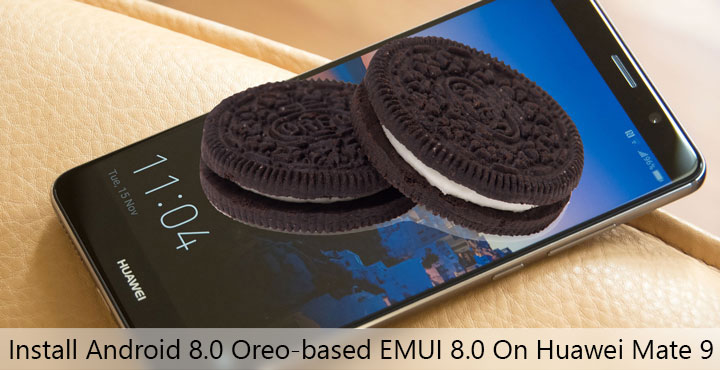
EMUI 8.0 builds, based on Android 8.0 Oreo has been seeping out slowly onto Huawei and Honor devices lately. Some officially and some through beta channels. Huawei Mate 9 is one of the devices to have received a full-fledged official update to Android Oreo and EMUI 8.0. The update brings the usual Android 8.0 features such as Picture-in-Picture while EMUI 8.0 brings in a set of its own unique new features. We’ve already discussed what’s new in EMUI 8.0. This is not a post about that but about how to install the Android 8.0 Oreo-based EMUI 8.0 on Huawei Mate 9.
You should already have received the OTA. But if you haven’t, or for whatever other reasons, you want to install it manually, here’s how. The original guide was put together by mankindtw but it could get a little bit confusing if you have never done this before. So here’s our guide based on his, hopefully, a bit more elaborative.
EMUI 8
Warning
First things first, flashing software on your phone yourself can be a bit risky. It probably won’t void your warranty but it could send you to the service center. In most cases flashing the original stock firmware almost always restores a device. Nevertheless, you must own up to it in case things do go south. DroidViews is not responsible for any damage to your phone. Proceed at your own risk.
Note
- Backup all of your important data – Call logs, messages, apps, everything on your internal storage. The entire slate on your phone will be wiped clean during the process.
- Make sure your Huawei Mate 9 has an unlocked bootloader. This is required to install the TWRP custom recovery. After the update, your device’s bootloader can be locked again.
- On your PC, install ADB and Fastboot along with any necessary USB drivers if you’re using a Windows PC. This is not a necessary requirement but the lack of ADB and USB drivers could potentially lead to some error later. Better safe than sorry.
- The firmware available for download below and the method to install them are both meant only for Huawei Mate 9 (MHA-L29/MHA-L09). Do not try it on any other device.
Firmware
- Device – Huawei Mate 9
- Model – MHA-L29/MHA-L09
- Android Version – 8.0
- EMUI Version – 8.0
- Firmware – B321
- Build Number – MHA-L29 8.0.0.321 (C432log/C636log)
- Region – Europe/Asia
- Status – Official
- Type – Full firmware image
Downloads
MHA-L29 8.0.0.321 (C432log) (Europe)
MHA-L29 8.0.0.321 (C636log) (Asia)
MHA-L09 (Europe)
HWOTA8 Package
- HWOTA8_2017110501.zip
How to install Android 8.0 Oreo-based EMUI 8.0 on Huawei Mate 9
- Download the correct firmware files (update.zip, update_full********.zip, update_data_full_public.zip) for your device and the HWOTA8 package from above.
- Extract the HWOTA8 zip package on your PC.
- Now connect your Mate 9 to your PC in fastboot mode with a USB cable. To do this you need to first power off the device. Then press and hold the volume key while it is powered off and connect the USB cable from your PC to your phone.
- Double-click on the Replace_Recovery.bat file in the extracted HWOTA8 folder. This will install TWRP recovery on your device.
- Disconnect your device when TWRP is installed and power it off. Boot it into TWRP by pressing and holding the Volume Up button while powering on the device. Leave the Power button when you see the Huawei logo.
- Once in TWRP recovery, connect your phone to your PC again.
- Create a folder named HWOTA8 on your device’s internal storage.
- Copy hwota8_update.zip, MHA_RECOVERY8_NoCheck.img (from the extracted HWOTA8 folder on your desktop) and the three firmware files inside the HWOTA8 folder on your device’s internal storage.
- In the TWRP main menu, select Install and then navigate to the HWOTA8 folder on your device’s internal storage.
- Select the hwota8_update.zip and then swipe at the bottom to flash it. It will install replace the TWRP recovery with a modded stock recovery and install the updates as well.
Wait for the update to install, it may take a little while. Once the update is complete you can go ahead and start using your device normally.
source: xda
![Install Android 8.0 Oreo Powered EMUI 8.0 Beta On Honor 8 Pro [Indian Variant]](https://www.droidviews.com/wp-content/uploads/2017/11/Honor_8_Pro_EMUI_8_Android_Oreo_6.jpg)
![Install Android 8.0 Oreo Powered EMUI 8.0 Beta On Honor 8 Pro [Indian Variant]](https://www.droidviews.com/wp-content/uploads/2017/11/Honor_8_Pro_EMUI_8_Android_Oreo_5.jpg)
![Install Android 8.0 Oreo Powered EMUI 8.0 Beta On Honor 8 Pro [Indian Variant]](https://www.droidviews.com/wp-content/uploads/2017/11/Honor_8_Pro_EMUI_8_Android_Oreo_4.jpg)
![Install Android 8.0 Oreo Powered EMUI 8.0 Beta On Honor 8 Pro [Indian Variant]](https://www.droidviews.com/wp-content/uploads/2017/11/Honor_8_Pro_EMUI_8_Android_Oreo_2.jpg)



Join The Discussion: